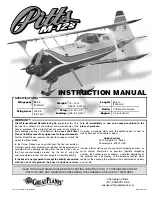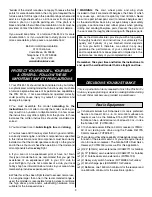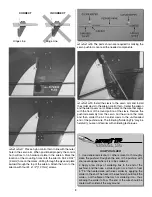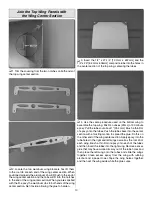
4
Engine Recommendations
The recommended engine size for the Pitts M-12s is a 50cc
gasoline engine with 3" [76mm] stand-offs. We used the
Desert Aircraft DA-50 rear carb engine for all of our fl ight
testing. This engine proved to be more than enough power
for vertical and hovering maneuvers. Remember that this is
a scale model that is intended to fl y at scale-like speeds,
so throttle management should be practiced. Information
on the DA-50 can be found at the Desert Aircraft website:
www.desertaircraft.com
Engine Spinner
Great Planes has a scale spinner made specifi cally for the
M-12s (GPMQ4020). This is a machine turned aluminum
spinner that rivals the highest quality spinners on the market.
The spinner is fi nished in metallic charcoal and matches the
metallic covering and paint on the airplane.
ADDITIONAL ITEMS REQUIRED
Required Hardware and Accessories
This is the list of hardware and accessories required to fi nish
the Pitts M-12s.
Order numbers are provided in parentheses.
❏
(6) Large scale 1" [25.4mm] single-sided servo arm
(GPMM1100)
❏
(1) Large scale 2.5" [64mm] double-sided servo arm
(GPMM1600)
❏
(1) R/C foam rubber (1/4" [6.4mm] - HCAQ1000
❏
(2) [914mm] 3' Dubro extra large tygon gasoline fuel
tubing [DUBQ0247]
❏
Drill bits: 1/16" [1.6mm], 5/64" [2mm], 3/32" [2.4mm],
1/8" [3.2mm], 3/16" [4.8mm], 1/4" [6.4mm].
❏
Silver solder w/fl ux (STAR2000)
❏
#1 Hobby knife (HCAR0105)
❏
#11 blades (5-pack, HCAR0211)
Adhesives and Building Supplies
This is the list of Adhesives and Building Supplies that are
required to fi nish the Pitts M-12s.
❏
1 oz. [30g] Thin Pro
™
CA (GPMR6002)
❏
1 oz. [30g] Medium Pro CA+ (GPMR6008)
❏
Pro 30-minute epoxy (GPMR6047)
❏
Pro 6-minute epoxy (GPMR6045)
❏
Microballoons (TOPR1090)
❏
Threadlocker thread locking cement (GPMR6060)
❏
Denatured alcohol (for epoxy clean up)
❏
Masking tape (TOPR8018)
❏
CA applicator tips (HCAR3780)
Optional Supplies and Tools
Here is a list of optional tools mentioned in the manual that
will help you build the Pitts M-12s.
❏
Small metal fi le
❏
21
st
Century
®
sealing iron (COVR2700)
❏
21
st
Century iron cover (COVR2702)
❏
4 oz. [113g] aerosol CA activator (GPMR6034)
❏
Epoxy brushes (6, GPMR8060)
❏
Mixing sticks (50, GPMR8055)
❏
Mixing cups (GPMR8056)
❏
Rotary tool such as Dremel
❏
Rotary tool reinforced cut-off wheel (GPMR8200)
❏
Stick-on segmented lead weights (GPMQ4485)
IMPORTANT BUILDING NOTES
• When you see the term
test fi t
in the instructions, it means
that you should fi rst position the part on the assembly
without using any glue
, then slightly modify or
custom fi t
the part as necessary for the best fi t.
•
Whenever the term
glue
is written you should rely upon
your experience to decide what type of glue to use. When
a specifi c type of adhesive works best for that step, the
instructions will make a recommendation.
•
Whenever just
epoxy
is specifi ed you may use
either
30-minute (or 45-minute) epoxy
or
6-minute epoxy. When
30-minute epoxy is specifi ed it is
highly
recommended that
you use only 30-minute (or 45-minute) epoxy, because you
will need the working time and/or the additional strength.
•
Photos
and
sketches
are placed
before
the step they
refer to. Frequently you can study photos in following steps
to get another view of the same parts.
•
The Pitts M-12s is factory-covered with Top Flite
®
MonoKote
®
fi lm. Should repairs ever be required, MonoKote can be
patched with additional MonoKote purchased separately.
MonoKote is packaged in six-foot rolls, but some hobby shops
also sell it by the foot. If only a small piece of MonoKote is
needed for a minor patch, perhaps a fellow modeler would
give you some. MonoKote is applied with a model airplane
covering iron, but in an emergency a regular iron could
be used. A roll of MonoKote includes full instructions for
application. Following are the colors used on this model and
order numbers for six foot rolls.
White
(TOPQ0204)
Orange
(TOPQ0202)
Metallic Charcoal (TOPQ0407)
Metallic Teal (TOPQ0409)
•
The stabilizer and wing incidences and engine thrust
angles have been factory-built into this model. However,
some technically-minded modelers may wish to check these
measurements anyway. To view this information visit the web
site at
www.greatplanes.com
and click on “Technical Data.”
Due to manufacturing tolerances which will have little or no
effect on the way your model will fl y, please expect slight
deviations between your model and the published values.





































